Critical Analysis of SBAR Tool for Nursing Practice Improvement
VerifiedAdded on 2020/12/09
|23
|5582
|165
Report
AI Summary
This report provides a critical analysis of a specific learning need in nursing practice, focusing on communication strategies and the use of the SBAR tool. The introduction highlights the importance of effective information transfer during shift changes to ensure patient safety, and the report emphasizes the role of Continuing Personal and Professional Development (CPPD) in reflecting on learning. The analysis explores the impact of poor communication on patient outcomes, citing research studies that support the use of the SBAR tool to improve communication among healthcare providers. The report examines the components of the SBAR tool and its application in various healthcare settings, including nurse-to-nurse handoffs and physician communication. The critical reflection section discusses how the findings can be applied to improve nursing practice, specifically focusing on how to enhance communication skills and reduce errors. The report underscores the need for standardized communication to improve patient safety and satisfaction. The conclusion emphasizes the importance of ongoing professional development and the implementation of evidence-based practices to improve patient care.
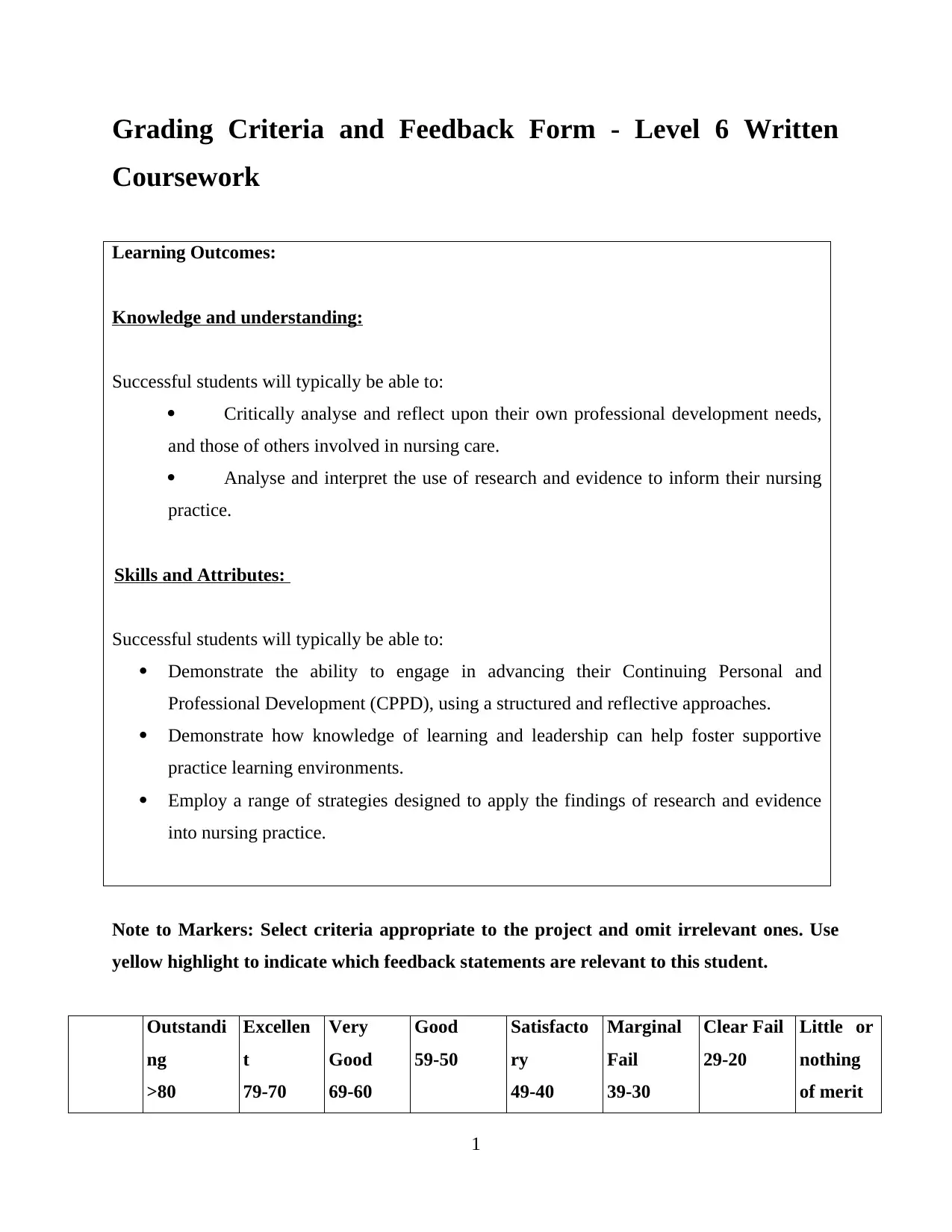
Grading Criteria and Feedback Form - Level 6 Written
Coursework
Learning Outcomes:
Knowledge and understanding:
Successful students will typically be able to:
Critically analyse and reflect upon their own professional development needs,
and those of others involved in nursing care.
Analyse and interpret the use of research and evidence to inform their nursing
practice.
Skills and Attributes:
Successful students will typically be able to:
Demonstrate the ability to engage in advancing their Continuing Personal and
Professional Development (CPPD), using a structured and reflective approaches.
Demonstrate how knowledge of learning and leadership can help foster supportive
practice learning environments.
Employ a range of strategies designed to apply the findings of research and evidence
into nursing practice.
Note to Markers: Select criteria appropriate to the project and omit irrelevant ones. Use
yellow highlight to indicate which feedback statements are relevant to this student.
Outstandi
ng
>80
Excellen
t
79-70
Very
Good
69-60
Good
59-50
Satisfacto
ry
49-40
Marginal
Fail
39-30
Clear Fail
29-20
Little or
nothing
of merit
1
Coursework
Learning Outcomes:
Knowledge and understanding:
Successful students will typically be able to:
Critically analyse and reflect upon their own professional development needs,
and those of others involved in nursing care.
Analyse and interpret the use of research and evidence to inform their nursing
practice.
Skills and Attributes:
Successful students will typically be able to:
Demonstrate the ability to engage in advancing their Continuing Personal and
Professional Development (CPPD), using a structured and reflective approaches.
Demonstrate how knowledge of learning and leadership can help foster supportive
practice learning environments.
Employ a range of strategies designed to apply the findings of research and evidence
into nursing practice.
Note to Markers: Select criteria appropriate to the project and omit irrelevant ones. Use
yellow highlight to indicate which feedback statements are relevant to this student.
Outstandi
ng
>80
Excellen
t
79-70
Very
Good
69-60
Good
59-50
Satisfacto
ry
49-40
Marginal
Fail
39-30
Clear Fail
29-20
Little or
nothing
of merit
1
Paraphrase This Document
Need a fresh take? Get an instant paraphrase of this document with our AI Paraphraser
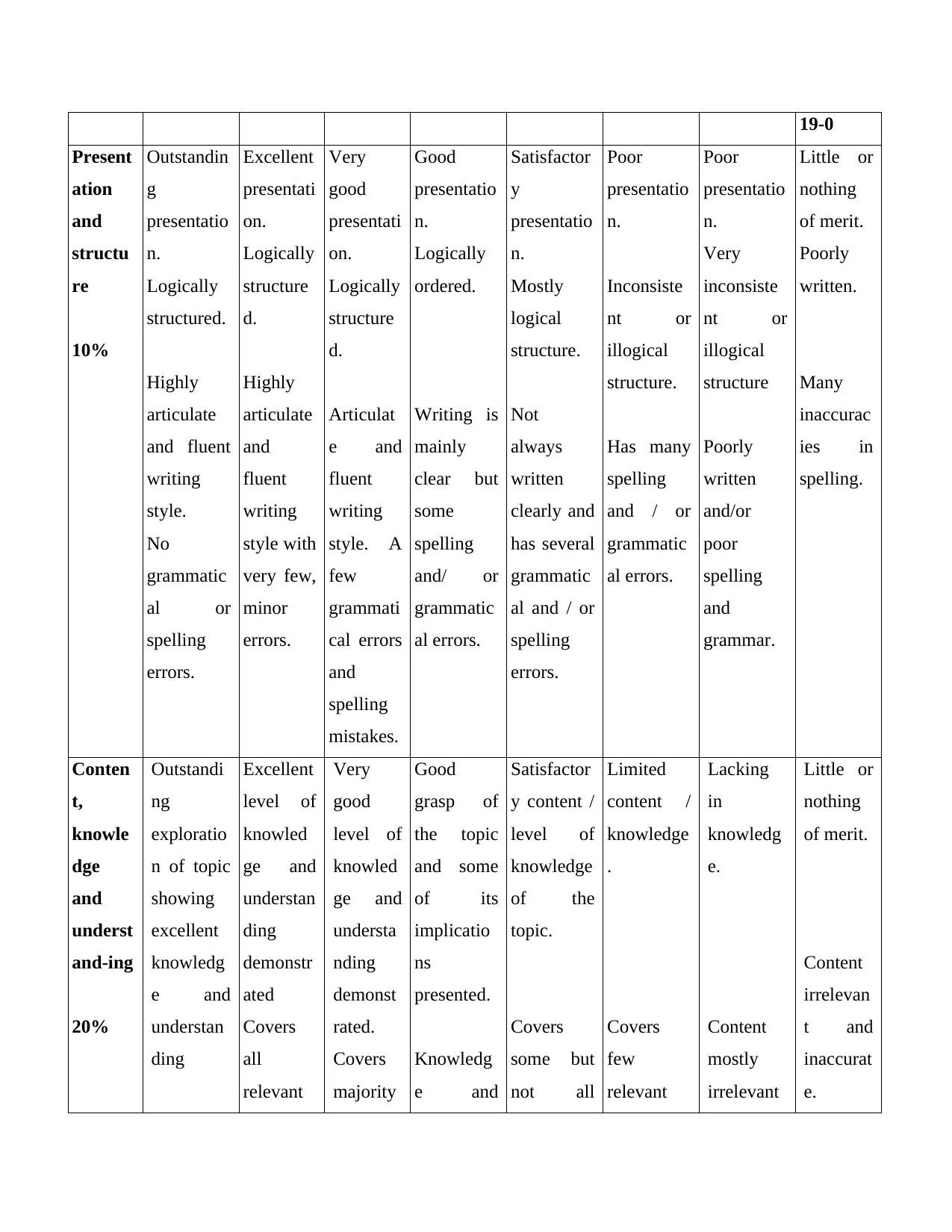
19-0
Present
ation
and
structu
re
10%
Outstandin
g
presentatio
n.
Logically
structured.
Highly
articulate
and fluent
writing
style.
No
grammatic
al or
spelling
errors.
Excellent
presentati
on.
Logically
structure
d.
Highly
articulate
and
fluent
writing
style with
very few,
minor
errors.
Very
good
presentati
on.
Logically
structure
d.
Articulat
e and
fluent
writing
style. A
few
grammati
cal errors
and
spelling
mistakes.
Good
presentatio
n.
Logically
ordered.
Writing is
mainly
clear but
some
spelling
and/ or
grammatic
al errors.
Satisfactor
y
presentatio
n.
Mostly
logical
structure.
Not
always
written
clearly and
has several
grammatic
al and / or
spelling
errors.
Poor
presentatio
n.
Inconsiste
nt or
illogical
structure.
Has many
spelling
and / or
grammatic
al errors.
Poor
presentatio
n.
Very
inconsiste
nt or
illogical
structure
Poorly
written
and/or
poor
spelling
and
grammar.
Little or
nothing
of merit.
Poorly
written.
Many
inaccurac
ies in
spelling.
Conten
t,
knowle
dge
and
underst
and-ing
20%
Outstandi
ng
exploratio
n of topic
showing
excellent
knowledg
e and
understan
ding
Excellent
level of
knowled
ge and
understan
ding
demonstr
ated
Covers
all
relevant
Very
good
level of
knowled
ge and
understa
nding
demonst
rated.
Covers
majority
Good
grasp of
the topic
and some
of its
implicatio
ns
presented.
Knowledg
e and
Satisfactor
y content /
level of
knowledge
of the
topic.
Covers
some but
not all
Limited
content /
knowledge
.
Covers
few
relevant
Lacking
in
knowledg
e.
Content
mostly
irrelevant
Little or
nothing
of merit.
Content
irrelevan
t and
inaccurat
e.
Present
ation
and
structu
re
10%
Outstandin
g
presentatio
n.
Logically
structured.
Highly
articulate
and fluent
writing
style.
No
grammatic
al or
spelling
errors.
Excellent
presentati
on.
Logically
structure
d.
Highly
articulate
and
fluent
writing
style with
very few,
minor
errors.
Very
good
presentati
on.
Logically
structure
d.
Articulat
e and
fluent
writing
style. A
few
grammati
cal errors
and
spelling
mistakes.
Good
presentatio
n.
Logically
ordered.
Writing is
mainly
clear but
some
spelling
and/ or
grammatic
al errors.
Satisfactor
y
presentatio
n.
Mostly
logical
structure.
Not
always
written
clearly and
has several
grammatic
al and / or
spelling
errors.
Poor
presentatio
n.
Inconsiste
nt or
illogical
structure.
Has many
spelling
and / or
grammatic
al errors.
Poor
presentatio
n.
Very
inconsiste
nt or
illogical
structure
Poorly
written
and/or
poor
spelling
and
grammar.
Little or
nothing
of merit.
Poorly
written.
Many
inaccurac
ies in
spelling.
Conten
t,
knowle
dge
and
underst
and-ing
20%
Outstandi
ng
exploratio
n of topic
showing
excellent
knowledg
e and
understan
ding
Excellent
level of
knowled
ge and
understan
ding
demonstr
ated
Covers
all
relevant
Very
good
level of
knowled
ge and
understa
nding
demonst
rated.
Covers
majority
Good
grasp of
the topic
and some
of its
implicatio
ns
presented.
Knowledg
e and
Satisfactor
y content /
level of
knowledge
of the
topic.
Covers
some but
not all
Limited
content /
knowledge
.
Covers
few
relevant
Lacking
in
knowledg
e.
Content
mostly
irrelevant
Little or
nothing
of merit.
Content
irrelevan
t and
inaccurat
e.
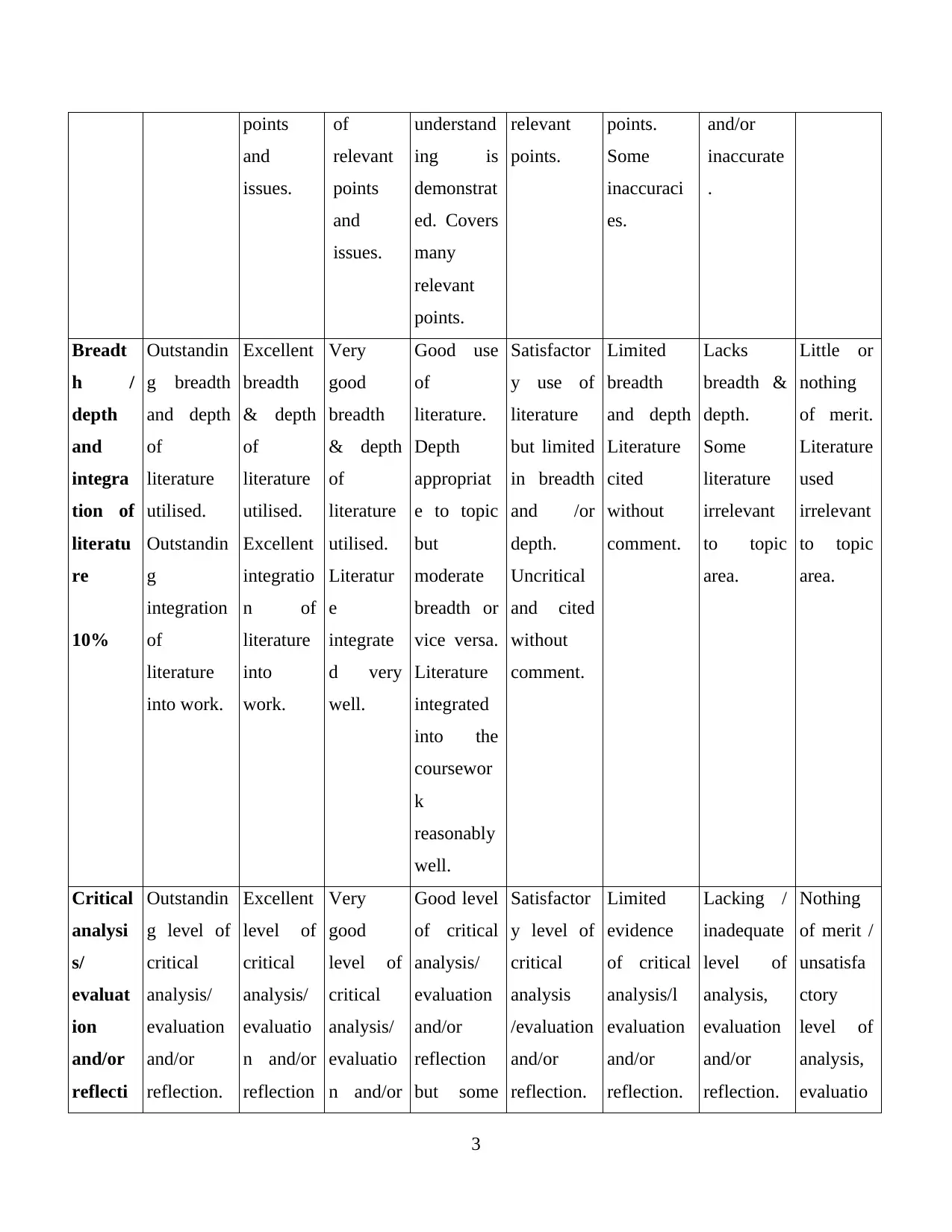
points
and
issues.
of
relevant
points
and
issues.
understand
ing is
demonstrat
ed. Covers
many
relevant
points.
relevant
points.
points.
Some
inaccuraci
es.
and/or
inaccurate
.
Breadt
h /
depth
and
integra
tion of
literatu
re
10%
Outstandin
g breadth
and depth
of
literature
utilised.
Outstandin
g
integration
of
literature
into work.
Excellent
breadth
& depth
of
literature
utilised.
Excellent
integratio
n of
literature
into
work.
Very
good
breadth
& depth
of
literature
utilised.
Literatur
e
integrate
d very
well.
Good use
of
literature.
Depth
appropriat
e to topic
but
moderate
breadth or
vice versa.
Literature
integrated
into the
coursewor
k
reasonably
well.
Satisfactor
y use of
literature
but limited
in breadth
and /or
depth.
Uncritical
and cited
without
comment.
Limited
breadth
and depth
Literature
cited
without
comment.
Lacks
breadth &
depth.
Some
literature
irrelevant
to topic
area.
Little or
nothing
of merit.
Literature
used
irrelevant
to topic
area.
Critical
analysi
s/
evaluat
ion
and/or
reflecti
Outstandin
g level of
critical
analysis/
evaluation
and/or
reflection.
Excellent
level of
critical
analysis/
evaluatio
n and/or
reflection
Very
good
level of
critical
analysis/
evaluatio
n and/or
Good level
of critical
analysis/
evaluation
and/or
reflection
but some
Satisfactor
y level of
critical
analysis
/evaluation
and/or
reflection.
Limited
evidence
of critical
analysis/l
evaluation
and/or
reflection.
Lacking /
inadequate
level of
analysis,
evaluation
and/or
reflection.
Nothing
of merit /
unsatisfa
ctory
level of
analysis,
evaluatio
3
and
issues.
of
relevant
points
and
issues.
understand
ing is
demonstrat
ed. Covers
many
relevant
points.
relevant
points.
points.
Some
inaccuraci
es.
and/or
inaccurate
.
Breadt
h /
depth
and
integra
tion of
literatu
re
10%
Outstandin
g breadth
and depth
of
literature
utilised.
Outstandin
g
integration
of
literature
into work.
Excellent
breadth
& depth
of
literature
utilised.
Excellent
integratio
n of
literature
into
work.
Very
good
breadth
& depth
of
literature
utilised.
Literatur
e
integrate
d very
well.
Good use
of
literature.
Depth
appropriat
e to topic
but
moderate
breadth or
vice versa.
Literature
integrated
into the
coursewor
k
reasonably
well.
Satisfactor
y use of
literature
but limited
in breadth
and /or
depth.
Uncritical
and cited
without
comment.
Limited
breadth
and depth
Literature
cited
without
comment.
Lacks
breadth &
depth.
Some
literature
irrelevant
to topic
area.
Little or
nothing
of merit.
Literature
used
irrelevant
to topic
area.
Critical
analysi
s/
evaluat
ion
and/or
reflecti
Outstandin
g level of
critical
analysis/
evaluation
and/or
reflection.
Excellent
level of
critical
analysis/
evaluatio
n and/or
reflection
Very
good
level of
critical
analysis/
evaluatio
n and/or
Good level
of critical
analysis/
evaluation
and/or
reflection
but some
Satisfactor
y level of
critical
analysis
/evaluation
and/or
reflection.
Limited
evidence
of critical
analysis/l
evaluation
and/or
reflection.
Lacking /
inadequate
level of
analysis,
evaluation
and/or
reflection.
Nothing
of merit /
unsatisfa
ctory
level of
analysis,
evaluatio
3
⊘ This is a preview!⊘
Do you want full access?
Subscribe today to unlock all pages.

Trusted by 1+ million students worldwide

on
55%
Highly
developed/
focused
work.
on issues. reflection
but a few
points
would
benefit
from
further
develop
ment.
areas
could be
expanded
on further.
Too
descriptive
in parts.
Mainly
descriptive
.
n and/ or
reflection
. Wholly
descriptiv
e.
Present
ation of
referen
ces
5%
Recomme
nded
referencin
g system
used with
no
inaccuraci
es or
inconsiste
ncies
noted.
Recomm
ended
referenci
ng
system
used with
very few
(minor)
inaccurac
ies and/or
inconsist
encies.
Recomm
ended
referenci
ng
system
used with
few
inaccurac
ies and/or
inconsist
encies.
Recomme
nded
referencin
g system
used but
occasional
inaccuraci
es and/or
inconsiste
ncies
noted.
An attempt
to use the
recommen
ded
referencin
g system
but several
inaccuraci
es and/or
inconsiste
ncies
noted.
An attempt
to use the
recommen
ded
referencin
g system
but many
inaccuraci
es and/or
inconsiste
ncies
noted.
An attempt
to use the
recommen
ded
referencin
g system
but
numerous
errors
noted and
inconsiste
ntly
applied.
Little or
no
attempt
to use the
recomme
nded
referenci
ng
system
Strengths
Areas for development
55%
Highly
developed/
focused
work.
on issues. reflection
but a few
points
would
benefit
from
further
develop
ment.
areas
could be
expanded
on further.
Too
descriptive
in parts.
Mainly
descriptive
.
n and/ or
reflection
. Wholly
descriptiv
e.
Present
ation of
referen
ces
5%
Recomme
nded
referencin
g system
used with
no
inaccuraci
es or
inconsiste
ncies
noted.
Recomm
ended
referenci
ng
system
used with
very few
(minor)
inaccurac
ies and/or
inconsist
encies.
Recomm
ended
referenci
ng
system
used with
few
inaccurac
ies and/or
inconsist
encies.
Recomme
nded
referencin
g system
used but
occasional
inaccuraci
es and/or
inconsiste
ncies
noted.
An attempt
to use the
recommen
ded
referencin
g system
but several
inaccuraci
es and/or
inconsiste
ncies
noted.
An attempt
to use the
recommen
ded
referencin
g system
but many
inaccuraci
es and/or
inconsiste
ncies
noted.
An attempt
to use the
recommen
ded
referencin
g system
but
numerous
errors
noted and
inconsiste
ntly
applied.
Little or
no
attempt
to use the
recomme
nded
referenci
ng
system
Strengths
Areas for development
Paraphrase This Document
Need a fresh take? Get an instant paraphrase of this document with our AI Paraphraser
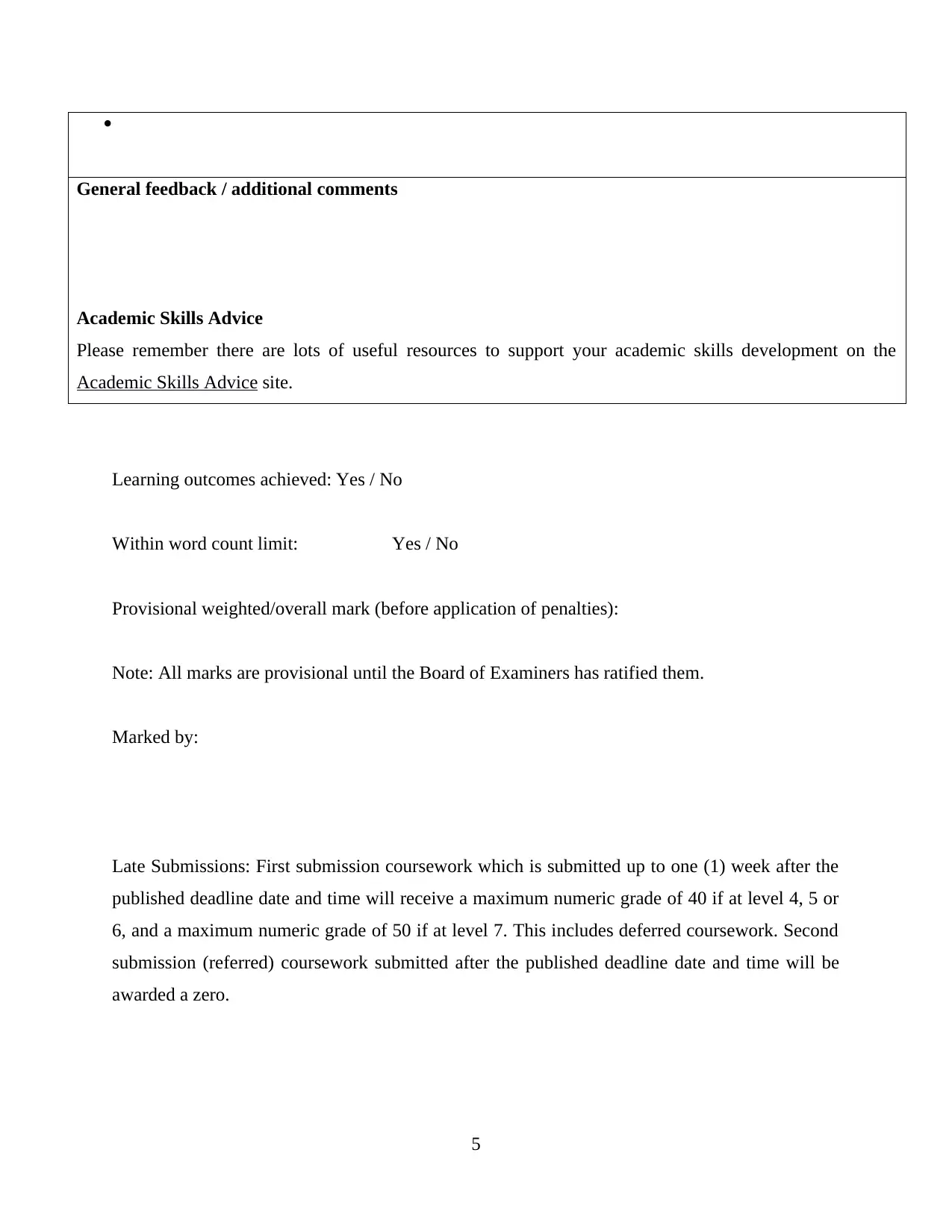
General feedback / additional comments
Academic Skills Advice
Please remember there are lots of useful resources to support your academic skills development on the
Academic Skills Advice site.
Learning outcomes achieved: Yes / No
Within word count limit: Yes / No
Provisional weighted/overall mark (before application of penalties):
Note: All marks are provisional until the Board of Examiners has ratified them.
Marked by:
Late Submissions: First submission coursework which is submitted up to one (1) week after the
published deadline date and time will receive a maximum numeric grade of 40 if at level 4, 5 or
6, and a maximum numeric grade of 50 if at level 7. This includes deferred coursework. Second
submission (referred) coursework submitted after the published deadline date and time will be
awarded a zero.
5
General feedback / additional comments
Academic Skills Advice
Please remember there are lots of useful resources to support your academic skills development on the
Academic Skills Advice site.
Learning outcomes achieved: Yes / No
Within word count limit: Yes / No
Provisional weighted/overall mark (before application of penalties):
Note: All marks are provisional until the Board of Examiners has ratified them.
Marked by:
Late Submissions: First submission coursework which is submitted up to one (1) week after the
published deadline date and time will receive a maximum numeric grade of 40 if at level 4, 5 or
6, and a maximum numeric grade of 50 if at level 7. This includes deferred coursework. Second
submission (referred) coursework submitted after the published deadline date and time will be
awarded a zero.
5
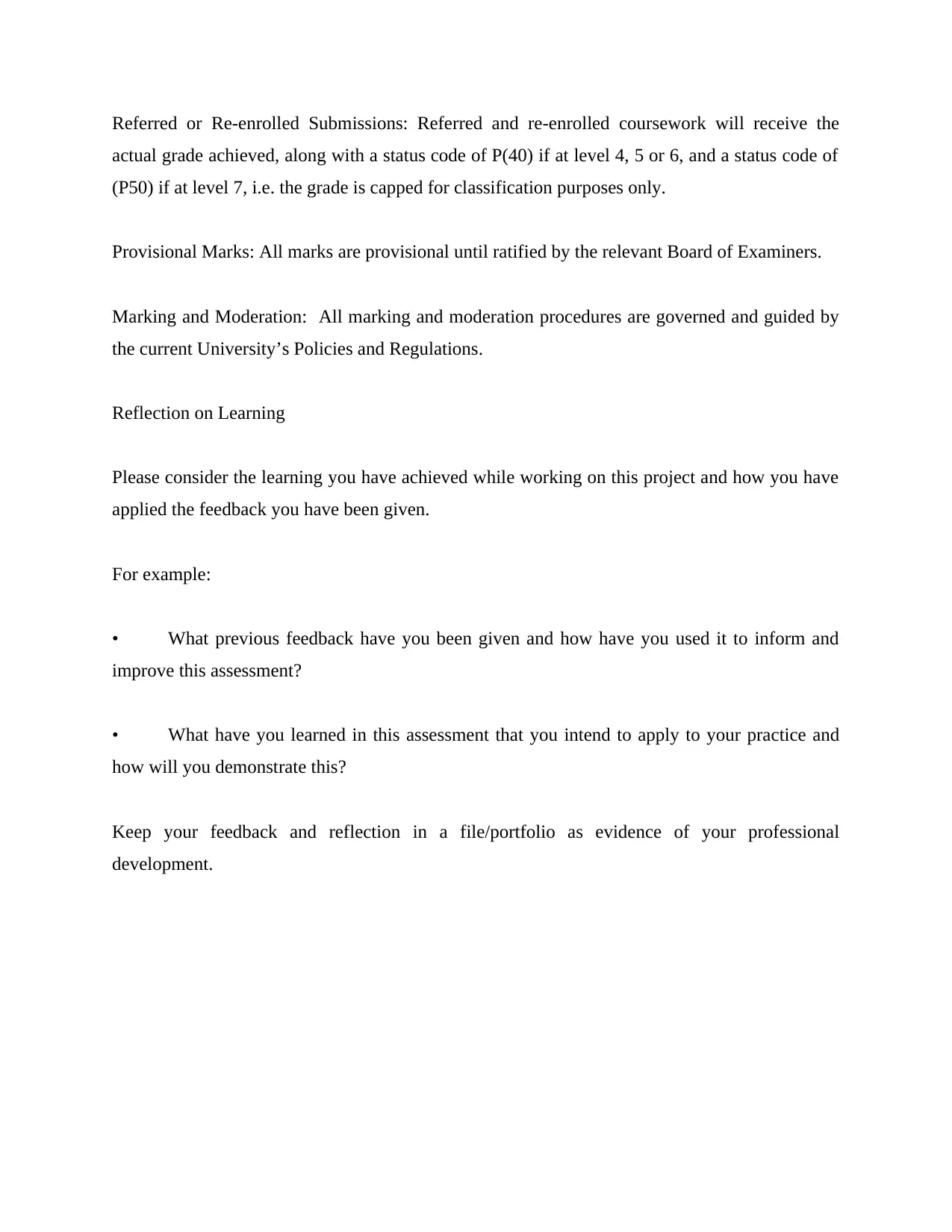
Referred or Re-enrolled Submissions: Referred and re-enrolled coursework will receive the
actual grade achieved, along with a status code of P(40) if at level 4, 5 or 6, and a status code of
(P50) if at level 7, i.e. the grade is capped for classification purposes only.
Provisional Marks: All marks are provisional until ratified by the relevant Board of Examiners.
Marking and Moderation: All marking and moderation procedures are governed and guided by
the current University’s Policies and Regulations.
Reflection on Learning
Please consider the learning you have achieved while working on this project and how you have
applied the feedback you have been given.
For example:
• What previous feedback have you been given and how have you used it to inform and
improve this assessment?
• What have you learned in this assessment that you intend to apply to your practice and
how will you demonstrate this?
Keep your feedback and reflection in a file/portfolio as evidence of your professional
development.
actual grade achieved, along with a status code of P(40) if at level 4, 5 or 6, and a status code of
(P50) if at level 7, i.e. the grade is capped for classification purposes only.
Provisional Marks: All marks are provisional until ratified by the relevant Board of Examiners.
Marking and Moderation: All marking and moderation procedures are governed and guided by
the current University’s Policies and Regulations.
Reflection on Learning
Please consider the learning you have achieved while working on this project and how you have
applied the feedback you have been given.
For example:
• What previous feedback have you been given and how have you used it to inform and
improve this assessment?
• What have you learned in this assessment that you intend to apply to your practice and
how will you demonstrate this?
Keep your feedback and reflection in a file/portfolio as evidence of your professional
development.
⊘ This is a preview!⊘
Do you want full access?
Subscribe today to unlock all pages.

Trusted by 1+ million students worldwide
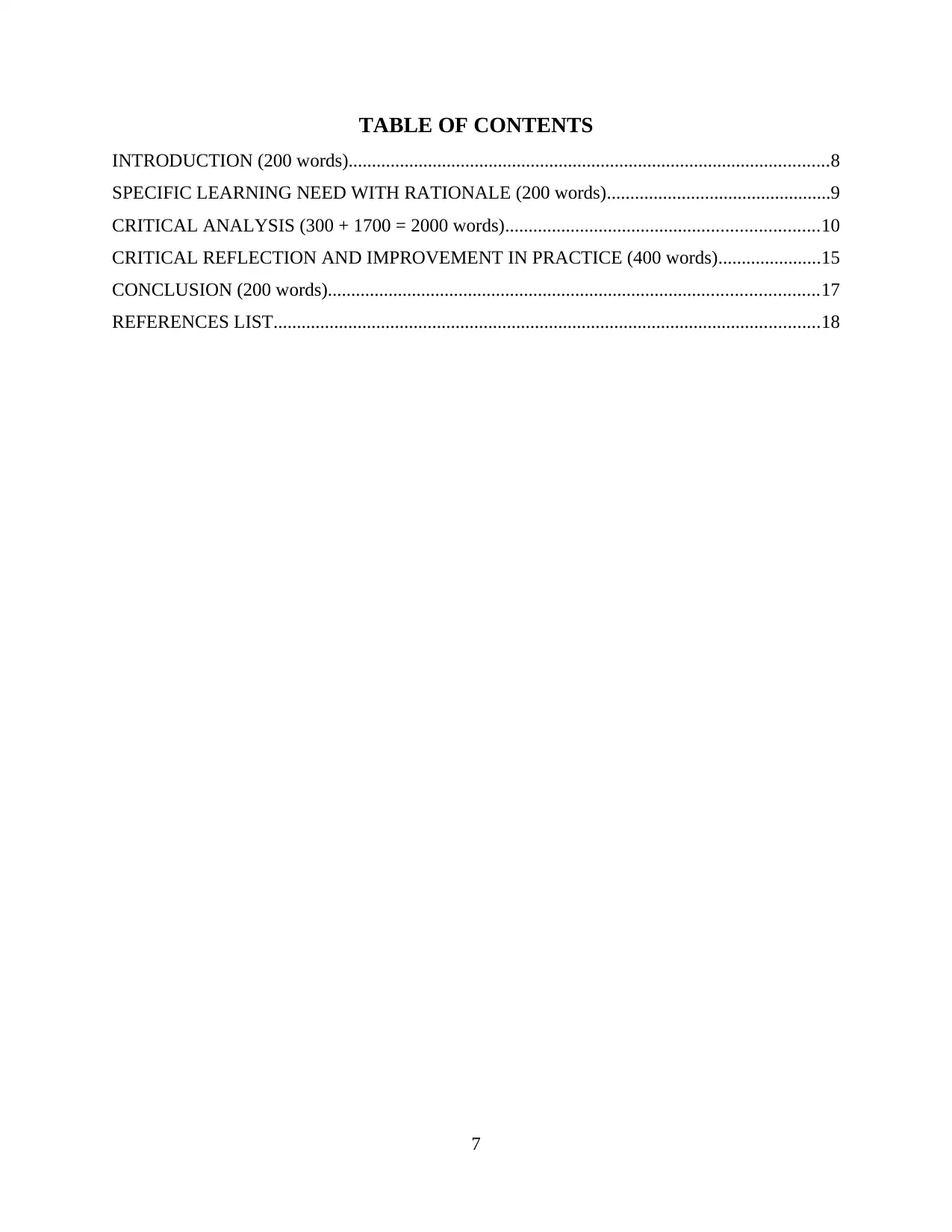
TABLE OF CONTENTS
INTRODUCTION (200 words).......................................................................................................8
SPECIFIC LEARNING NEED WITH RATIONALE (200 words)................................................9
CRITICAL ANALYSIS (300 + 1700 = 2000 words)...................................................................10
CRITICAL REFLECTION AND IMPROVEMENT IN PRACTICE (400 words)......................15
CONCLUSION (200 words).........................................................................................................17
REFERENCES LIST.....................................................................................................................18
7
INTRODUCTION (200 words).......................................................................................................8
SPECIFIC LEARNING NEED WITH RATIONALE (200 words)................................................9
CRITICAL ANALYSIS (300 + 1700 = 2000 words)...................................................................10
CRITICAL REFLECTION AND IMPROVEMENT IN PRACTICE (400 words)......................15
CONCLUSION (200 words).........................................................................................................17
REFERENCES LIST.....................................................................................................................18
7
Paraphrase This Document
Need a fresh take? Get an instant paraphrase of this document with our AI Paraphraser

Summative Project
Identify ONE specific learning need which you feel you need to develop your nursing practice.
This specific learning need must relate to ONE of the areas for development that has been
highlighted in your ‘PAD’ or ‘OAR’ and it must be appropriate for a third year student nurse.
Critically analyse at least 2 up to date research studies that relate to your specific learning need,
ensuring you also use many other sources of evidence to support your critical analysis. Critically
reflect on what you have learnt from the evidence in relation to your nursing practice. Critically
reflect on how you will improve your practice as a THIRD YEAR student nurse in relation to the
evidence you have critically analysed.
Please write your essay here (Below is a template that you can follow, please ensure that you
remove the subheadings before submission and please include the word count. The word count is
+/- 10% and the maximum word count is 3,300 words)
Identify ONE specific learning need which you feel you need to develop your nursing practice.
This specific learning need must relate to ONE of the areas for development that has been
highlighted in your ‘PAD’ or ‘OAR’ and it must be appropriate for a third year student nurse.
Critically analyse at least 2 up to date research studies that relate to your specific learning need,
ensuring you also use many other sources of evidence to support your critical analysis. Critically
reflect on what you have learnt from the evidence in relation to your nursing practice. Critically
reflect on how you will improve your practice as a THIRD YEAR student nurse in relation to the
evidence you have critically analysed.
Please write your essay here (Below is a template that you can follow, please ensure that you
remove the subheadings before submission and please include the word count. The word count is
+/- 10% and the maximum word count is 3,300 words)

INTRODUCTION (200 words)
The fundamental aim of any handover is to accomplish efficient transfer of high quality
clinical information at the time of transition of responsibility for patient. Shift work also relies on
effective information that transfers to protect the patient’s safety (De Brún, Heavey and Scott,
2017). Present report provides critical discussion to maintain ongoing confidentiality regarding
patient’s records. Nursing changes in shift with communication can be occur between different
aspects of nurses for accomplish specific purpose. To communicate information regarding
patient’s care has been taken for nurses effectively. There are two articles taken in which
importance of SBAR tool is considered as an evidence into nursing practices.
In one article, SBAR tool explained for communication and patient’s safety which is
considered to be an integrated literature review. For this purpose in this report Continuing
Personal and Professional Development (CPPD) will be used so that learner could be able to
reflect upon what is learned and what development needs to be done. Within the particular error
of communication, there are prevalent sources of miscalculation and misdirection in healthcare
field. On the other hand, another article shows that without standardisation and communication
in between healthcare providers, patient’s safety may be in jeopardy. Therefore, it is the key
component to provide proper care and meet with improvement with high quality of care.
SPECIFIC LEARNING NEED WITH RATIONALE (200 words)
Communication is an essential part of healthcare which means transfer of information
related to patients which will be done in between 2 or more people. However, there could also be
many chances where poor or lack of communication has been found that would be leading to
sentinel events. The present study is based on methods of improving communication process
among bedside nursing staff and skilled nursing rehabilitation unit (Acharya, Thomas and
Hellaby, 2017). So under this evidence based communication through use of SBAR tool at time
of bed handoff which is having positive impact on reducing falling rates. For this random
controlled trails (RCT) that evaluated the handover style between the nurses within hospital
setting is used. According to this consideration, it can be stated that healthcare system is more
often with root cause of errors that traced to faulty systematic processes.
9
The fundamental aim of any handover is to accomplish efficient transfer of high quality
clinical information at the time of transition of responsibility for patient. Shift work also relies on
effective information that transfers to protect the patient’s safety (De Brún, Heavey and Scott,
2017). Present report provides critical discussion to maintain ongoing confidentiality regarding
patient’s records. Nursing changes in shift with communication can be occur between different
aspects of nurses for accomplish specific purpose. To communicate information regarding
patient’s care has been taken for nurses effectively. There are two articles taken in which
importance of SBAR tool is considered as an evidence into nursing practices.
In one article, SBAR tool explained for communication and patient’s safety which is
considered to be an integrated literature review. For this purpose in this report Continuing
Personal and Professional Development (CPPD) will be used so that learner could be able to
reflect upon what is learned and what development needs to be done. Within the particular error
of communication, there are prevalent sources of miscalculation and misdirection in healthcare
field. On the other hand, another article shows that without standardisation and communication
in between healthcare providers, patient’s safety may be in jeopardy. Therefore, it is the key
component to provide proper care and meet with improvement with high quality of care.
SPECIFIC LEARNING NEED WITH RATIONALE (200 words)
Communication is an essential part of healthcare which means transfer of information
related to patients which will be done in between 2 or more people. However, there could also be
many chances where poor or lack of communication has been found that would be leading to
sentinel events. The present study is based on methods of improving communication process
among bedside nursing staff and skilled nursing rehabilitation unit (Acharya, Thomas and
Hellaby, 2017). So under this evidence based communication through use of SBAR tool at time
of bed handoff which is having positive impact on reducing falling rates. For this random
controlled trails (RCT) that evaluated the handover style between the nurses within hospital
setting is used. According to this consideration, it can be stated that healthcare system is more
often with root cause of errors that traced to faulty systematic processes.
9
⊘ This is a preview!⊘
Do you want full access?
Subscribe today to unlock all pages.

Trusted by 1+ million students worldwide
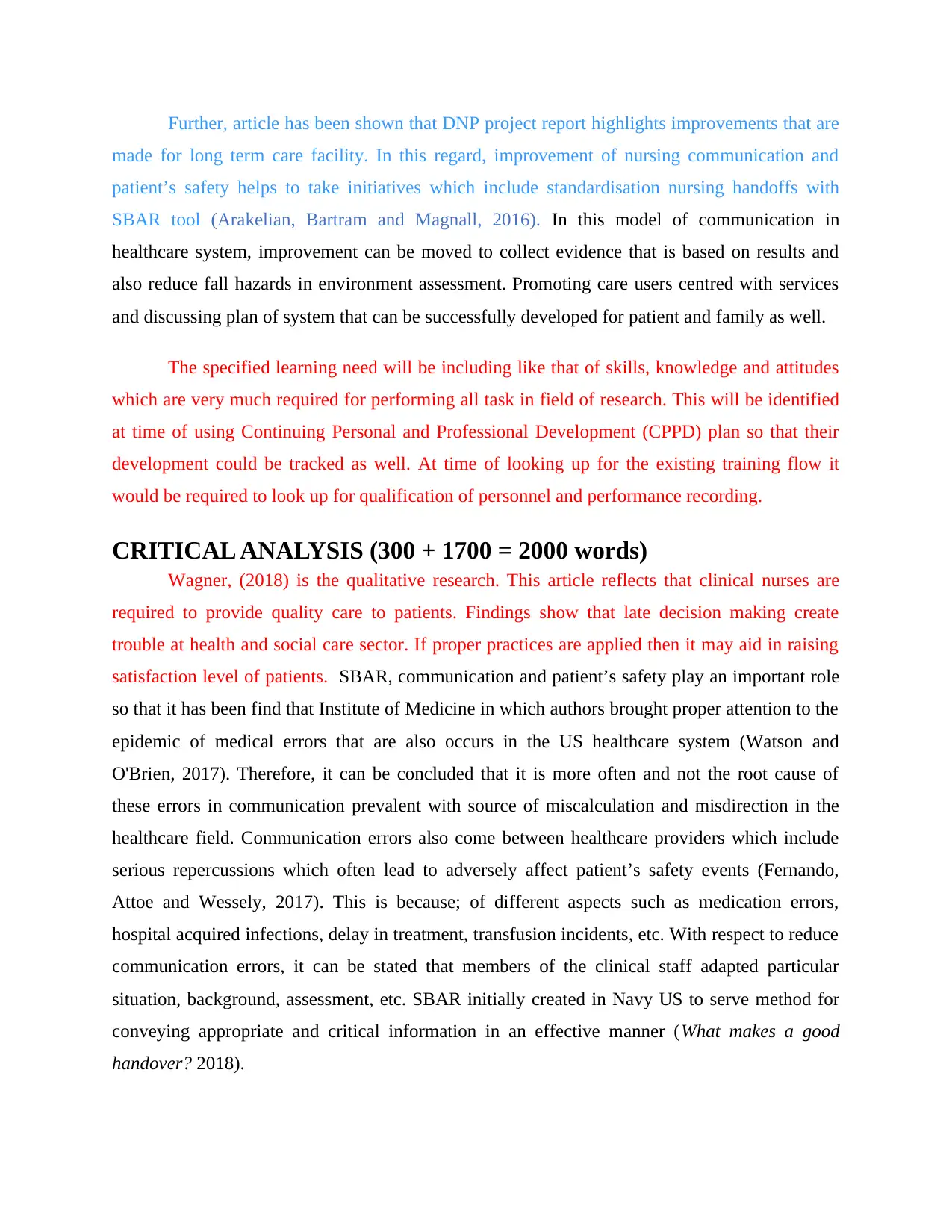
Further, article has been shown that DNP project report highlights improvements that are
made for long term care facility. In this regard, improvement of nursing communication and
patient’s safety helps to take initiatives which include standardisation nursing handoffs with
SBAR tool (Arakelian, Bartram and Magnall, 2016). In this model of communication in
healthcare system, improvement can be moved to collect evidence that is based on results and
also reduce fall hazards in environment assessment. Promoting care users centred with services
and discussing plan of system that can be successfully developed for patient and family as well.
The specified learning need will be including like that of skills, knowledge and attitudes
which are very much required for performing all task in field of research. This will be identified
at time of using Continuing Personal and Professional Development (CPPD) plan so that their
development could be tracked as well. At time of looking up for the existing training flow it
would be required to look up for qualification of personnel and performance recording.
CRITICAL ANALYSIS (300 + 1700 = 2000 words)
Wagner, (2018) is the qualitative research. This article reflects that clinical nurses are
required to provide quality care to patients. Findings show that late decision making create
trouble at health and social care sector. If proper practices are applied then it may aid in raising
satisfaction level of patients. SBAR, communication and patient’s safety play an important role
so that it has been find that Institute of Medicine in which authors brought proper attention to the
epidemic of medical errors that are also occurs in the US healthcare system (Watson and
O'Brien, 2017). Therefore, it can be concluded that it is more often and not the root cause of
these errors in communication prevalent with source of miscalculation and misdirection in the
healthcare field. Communication errors also come between healthcare providers which include
serious repercussions which often lead to adversely affect patient’s safety events (Fernando,
Attoe and Wessely, 2017). This is because; of different aspects such as medication errors,
hospital acquired infections, delay in treatment, transfusion incidents, etc. With respect to reduce
communication errors, it can be stated that members of the clinical staff adapted particular
situation, background, assessment, etc. SBAR initially created in Navy US to serve method for
conveying appropriate and critical information in an effective manner (What makes a good
handover? 2018).
made for long term care facility. In this regard, improvement of nursing communication and
patient’s safety helps to take initiatives which include standardisation nursing handoffs with
SBAR tool (Arakelian, Bartram and Magnall, 2016). In this model of communication in
healthcare system, improvement can be moved to collect evidence that is based on results and
also reduce fall hazards in environment assessment. Promoting care users centred with services
and discussing plan of system that can be successfully developed for patient and family as well.
The specified learning need will be including like that of skills, knowledge and attitudes
which are very much required for performing all task in field of research. This will be identified
at time of using Continuing Personal and Professional Development (CPPD) plan so that their
development could be tracked as well. At time of looking up for the existing training flow it
would be required to look up for qualification of personnel and performance recording.
CRITICAL ANALYSIS (300 + 1700 = 2000 words)
Wagner, (2018) is the qualitative research. This article reflects that clinical nurses are
required to provide quality care to patients. Findings show that late decision making create
trouble at health and social care sector. If proper practices are applied then it may aid in raising
satisfaction level of patients. SBAR, communication and patient’s safety play an important role
so that it has been find that Institute of Medicine in which authors brought proper attention to the
epidemic of medical errors that are also occurs in the US healthcare system (Watson and
O'Brien, 2017). Therefore, it can be concluded that it is more often and not the root cause of
these errors in communication prevalent with source of miscalculation and misdirection in the
healthcare field. Communication errors also come between healthcare providers which include
serious repercussions which often lead to adversely affect patient’s safety events (Fernando,
Attoe and Wessely, 2017). This is because; of different aspects such as medication errors,
hospital acquired infections, delay in treatment, transfusion incidents, etc. With respect to reduce
communication errors, it can be stated that members of the clinical staff adapted particular
situation, background, assessment, etc. SBAR initially created in Navy US to serve method for
conveying appropriate and critical information in an effective manner (What makes a good
handover? 2018).
Paraphrase This Document
Need a fresh take? Get an instant paraphrase of this document with our AI Paraphraser
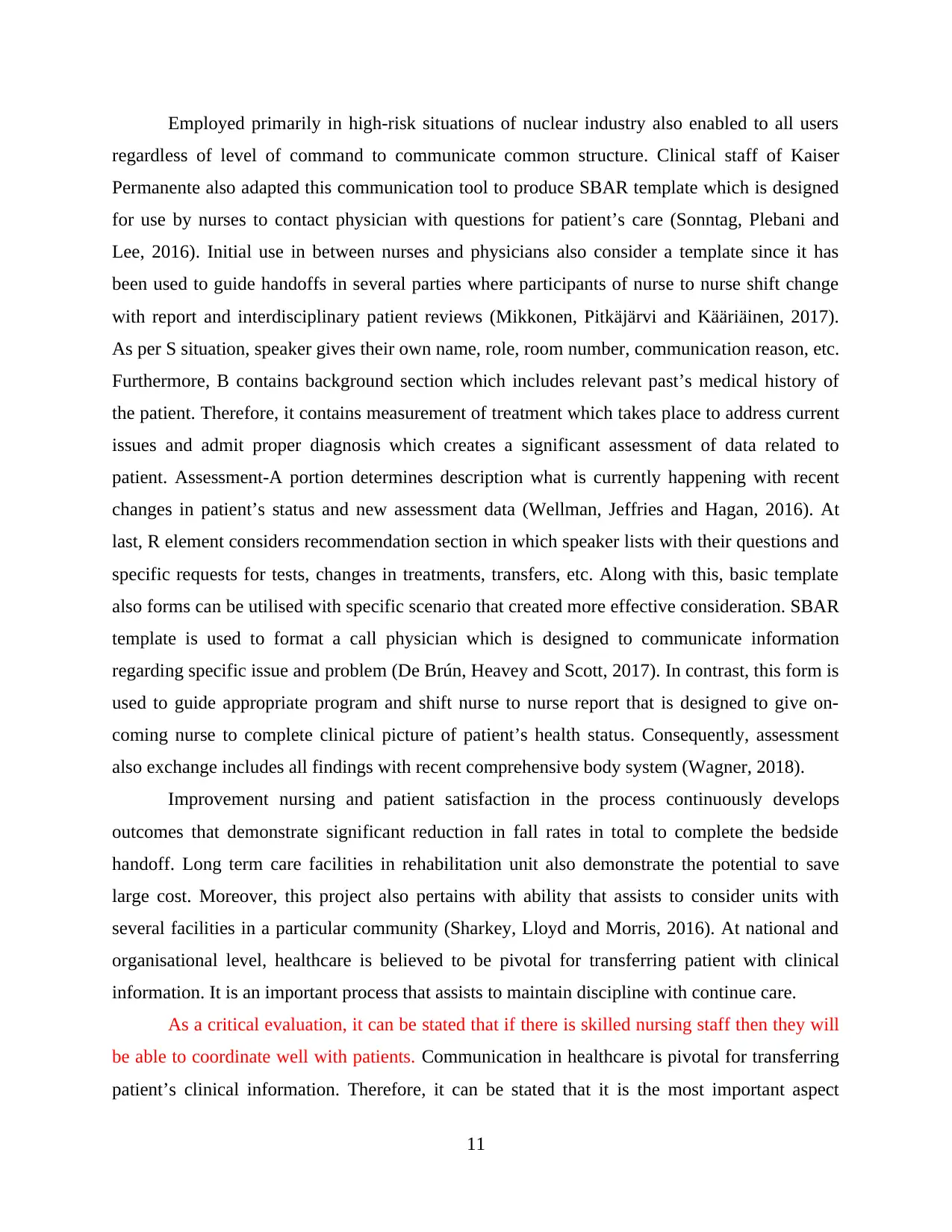
Employed primarily in high-risk situations of nuclear industry also enabled to all users
regardless of level of command to communicate common structure. Clinical staff of Kaiser
Permanente also adapted this communication tool to produce SBAR template which is designed
for use by nurses to contact physician with questions for patient’s care (Sonntag, Plebani and
Lee, 2016). Initial use in between nurses and physicians also consider a template since it has
been used to guide handoffs in several parties where participants of nurse to nurse shift change
with report and interdisciplinary patient reviews (Mikkonen, Pitkäjärvi and Kääriäinen, 2017).
As per S situation, speaker gives their own name, role, room number, communication reason, etc.
Furthermore, B contains background section which includes relevant past’s medical history of
the patient. Therefore, it contains measurement of treatment which takes place to address current
issues and admit proper diagnosis which creates a significant assessment of data related to
patient. Assessment-A portion determines description what is currently happening with recent
changes in patient’s status and new assessment data (Wellman, Jeffries and Hagan, 2016). At
last, R element considers recommendation section in which speaker lists with their questions and
specific requests for tests, changes in treatments, transfers, etc. Along with this, basic template
also forms can be utilised with specific scenario that created more effective consideration. SBAR
template is used to format a call physician which is designed to communicate information
regarding specific issue and problem (De Brún, Heavey and Scott, 2017). In contrast, this form is
used to guide appropriate program and shift nurse to nurse report that is designed to give on-
coming nurse to complete clinical picture of patient’s health status. Consequently, assessment
also exchange includes all findings with recent comprehensive body system (Wagner, 2018).
Improvement nursing and patient satisfaction in the process continuously develops
outcomes that demonstrate significant reduction in fall rates in total to complete the bedside
handoff. Long term care facilities in rehabilitation unit also demonstrate the potential to save
large cost. Moreover, this project also pertains with ability that assists to consider units with
several facilities in a particular community (Sharkey, Lloyd and Morris, 2016). At national and
organisational level, healthcare is believed to be pivotal for transferring patient with clinical
information. It is an important process that assists to maintain discipline with continue care.
As a critical evaluation, it can be stated that if there is skilled nursing staff then they will
be able to coordinate well with patients. Communication in healthcare is pivotal for transferring
patient’s clinical information. Therefore, it can be stated that it is the most important aspect
11
regardless of level of command to communicate common structure. Clinical staff of Kaiser
Permanente also adapted this communication tool to produce SBAR template which is designed
for use by nurses to contact physician with questions for patient’s care (Sonntag, Plebani and
Lee, 2016). Initial use in between nurses and physicians also consider a template since it has
been used to guide handoffs in several parties where participants of nurse to nurse shift change
with report and interdisciplinary patient reviews (Mikkonen, Pitkäjärvi and Kääriäinen, 2017).
As per S situation, speaker gives their own name, role, room number, communication reason, etc.
Furthermore, B contains background section which includes relevant past’s medical history of
the patient. Therefore, it contains measurement of treatment which takes place to address current
issues and admit proper diagnosis which creates a significant assessment of data related to
patient. Assessment-A portion determines description what is currently happening with recent
changes in patient’s status and new assessment data (Wellman, Jeffries and Hagan, 2016). At
last, R element considers recommendation section in which speaker lists with their questions and
specific requests for tests, changes in treatments, transfers, etc. Along with this, basic template
also forms can be utilised with specific scenario that created more effective consideration. SBAR
template is used to format a call physician which is designed to communicate information
regarding specific issue and problem (De Brún, Heavey and Scott, 2017). In contrast, this form is
used to guide appropriate program and shift nurse to nurse report that is designed to give on-
coming nurse to complete clinical picture of patient’s health status. Consequently, assessment
also exchange includes all findings with recent comprehensive body system (Wagner, 2018).
Improvement nursing and patient satisfaction in the process continuously develops
outcomes that demonstrate significant reduction in fall rates in total to complete the bedside
handoff. Long term care facilities in rehabilitation unit also demonstrate the potential to save
large cost. Moreover, this project also pertains with ability that assists to consider units with
several facilities in a particular community (Sharkey, Lloyd and Morris, 2016). At national and
organisational level, healthcare is believed to be pivotal for transferring patient with clinical
information. It is an important process that assists to maintain discipline with continue care.
As a critical evaluation, it can be stated that if there is skilled nursing staff then they will
be able to coordinate well with patients. Communication in healthcare is pivotal for transferring
patient’s clinical information. Therefore, it can be stated that it is the most important aspect
11
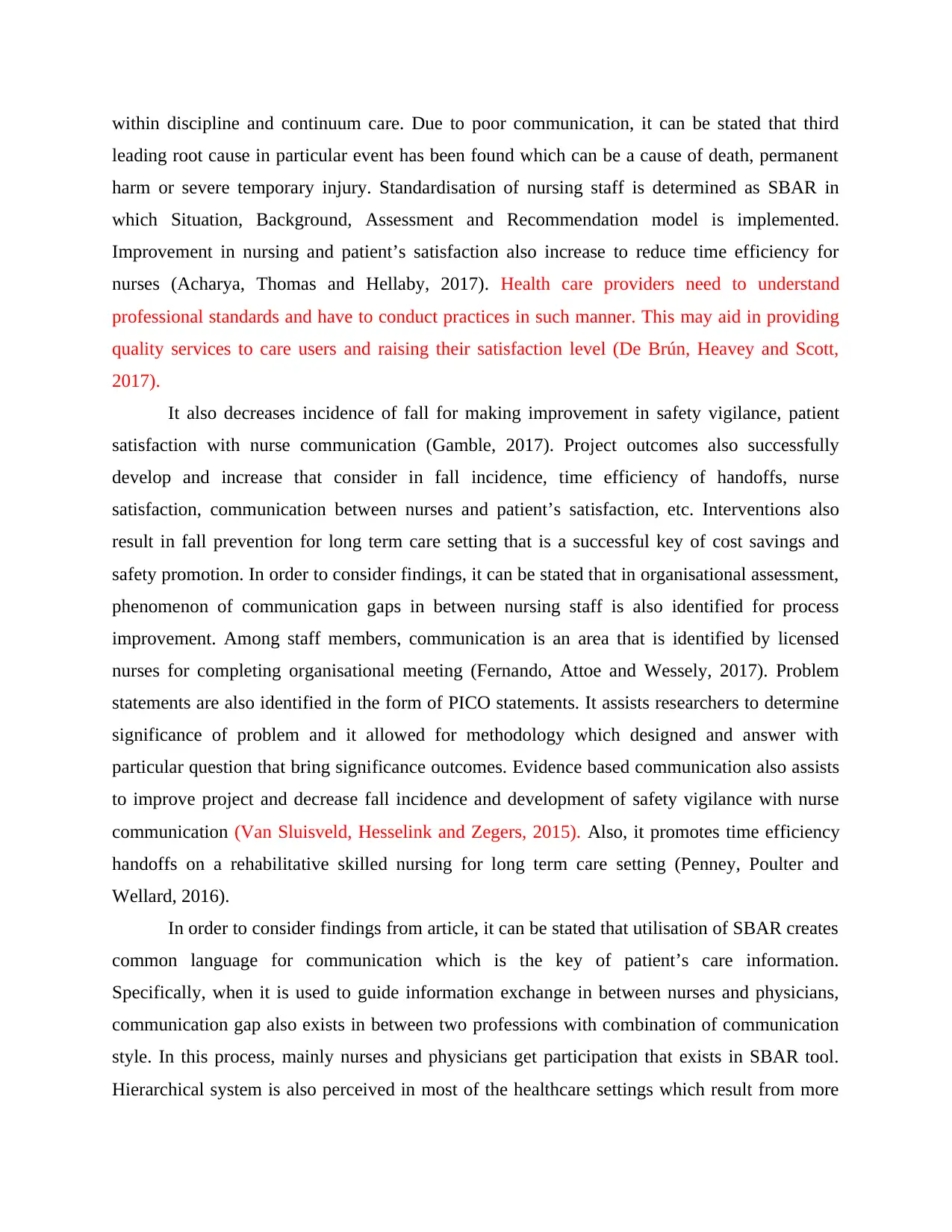
within discipline and continuum care. Due to poor communication, it can be stated that third
leading root cause in particular event has been found which can be a cause of death, permanent
harm or severe temporary injury. Standardisation of nursing staff is determined as SBAR in
which Situation, Background, Assessment and Recommendation model is implemented.
Improvement in nursing and patient’s satisfaction also increase to reduce time efficiency for
nurses (Acharya, Thomas and Hellaby, 2017). Health care providers need to understand
professional standards and have to conduct practices in such manner. This may aid in providing
quality services to care users and raising their satisfaction level (De Brún, Heavey and Scott,
2017).
It also decreases incidence of fall for making improvement in safety vigilance, patient
satisfaction with nurse communication (Gamble, 2017). Project outcomes also successfully
develop and increase that consider in fall incidence, time efficiency of handoffs, nurse
satisfaction, communication between nurses and patient’s satisfaction, etc. Interventions also
result in fall prevention for long term care setting that is a successful key of cost savings and
safety promotion. In order to consider findings, it can be stated that in organisational assessment,
phenomenon of communication gaps in between nursing staff is also identified for process
improvement. Among staff members, communication is an area that is identified by licensed
nurses for completing organisational meeting (Fernando, Attoe and Wessely, 2017). Problem
statements are also identified in the form of PICO statements. It assists researchers to determine
significance of problem and it allowed for methodology which designed and answer with
particular question that bring significance outcomes. Evidence based communication also assists
to improve project and decrease fall incidence and development of safety vigilance with nurse
communication (Van Sluisveld, Hesselink and Zegers, 2015). Also, it promotes time efficiency
handoffs on a rehabilitative skilled nursing for long term care setting (Penney, Poulter and
Wellard, 2016).
In order to consider findings from article, it can be stated that utilisation of SBAR creates
common language for communication which is the key of patient’s care information.
Specifically, when it is used to guide information exchange in between nurses and physicians,
communication gap also exists in between two professions with combination of communication
style. In this process, mainly nurses and physicians get participation that exists in SBAR tool.
Hierarchical system is also perceived in most of the healthcare settings which result from more
leading root cause in particular event has been found which can be a cause of death, permanent
harm or severe temporary injury. Standardisation of nursing staff is determined as SBAR in
which Situation, Background, Assessment and Recommendation model is implemented.
Improvement in nursing and patient’s satisfaction also increase to reduce time efficiency for
nurses (Acharya, Thomas and Hellaby, 2017). Health care providers need to understand
professional standards and have to conduct practices in such manner. This may aid in providing
quality services to care users and raising their satisfaction level (De Brún, Heavey and Scott,
2017).
It also decreases incidence of fall for making improvement in safety vigilance, patient
satisfaction with nurse communication (Gamble, 2017). Project outcomes also successfully
develop and increase that consider in fall incidence, time efficiency of handoffs, nurse
satisfaction, communication between nurses and patient’s satisfaction, etc. Interventions also
result in fall prevention for long term care setting that is a successful key of cost savings and
safety promotion. In order to consider findings, it can be stated that in organisational assessment,
phenomenon of communication gaps in between nursing staff is also identified for process
improvement. Among staff members, communication is an area that is identified by licensed
nurses for completing organisational meeting (Fernando, Attoe and Wessely, 2017). Problem
statements are also identified in the form of PICO statements. It assists researchers to determine
significance of problem and it allowed for methodology which designed and answer with
particular question that bring significance outcomes. Evidence based communication also assists
to improve project and decrease fall incidence and development of safety vigilance with nurse
communication (Van Sluisveld, Hesselink and Zegers, 2015). Also, it promotes time efficiency
handoffs on a rehabilitative skilled nursing for long term care setting (Penney, Poulter and
Wellard, 2016).
In order to consider findings from article, it can be stated that utilisation of SBAR creates
common language for communication which is the key of patient’s care information.
Specifically, when it is used to guide information exchange in between nurses and physicians,
communication gap also exists in between two professions with combination of communication
style. In this process, mainly nurses and physicians get participation that exists in SBAR tool.
Hierarchical system is also perceived in most of the healthcare settings which result from more
⊘ This is a preview!⊘
Do you want full access?
Subscribe today to unlock all pages.

Trusted by 1+ million students worldwide
1 out of 23
Related Documents
Your All-in-One AI-Powered Toolkit for Academic Success.
+13062052269
info@desklib.com
Available 24*7 on WhatsApp / Email
![[object Object]](/_next/static/media/star-bottom.7253800d.svg)
Unlock your academic potential
Copyright © 2020–2025 A2Z Services. All Rights Reserved. Developed and managed by ZUCOL.





